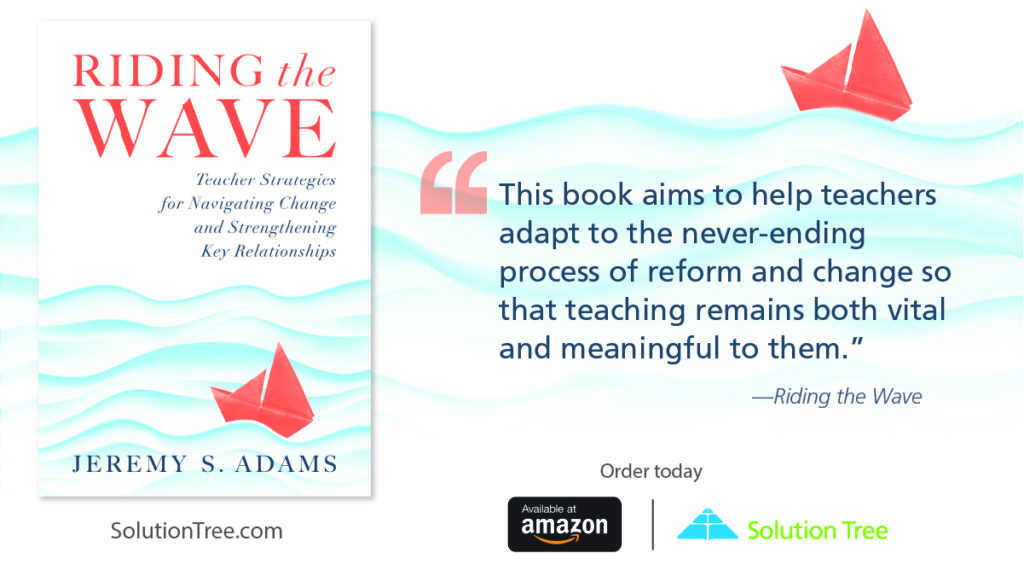This entry is the first in a blog series called Pandemic Response and Educational Practices (PREP), which aims to highlight and further the important work educators are doing amid the worldwide COVID-19 crisis.
Based on Riding the Wave.
Teachers are used to standing at the water’s edge, peering into the distance and seeing wave after wave of change coming their way. It can certainly be daunting.
Usually, teachers can correctly gauge how much time they have before these waves come crashing over them.
However, the COVID-19 global pandemic represents a series of powerful and unforeseen waves that are already upon us in the teaching profession. These waves arrived with little to no warning. As of this writing, forty-six states have closed schools, affecting 54.8 million students. Now, American teachers and their students are scrambling to confront sudden challenges they never imagined they would have to meet.
These new challenges have been suddenly thrust upon teachers from all walks of life, teaching every type of student and at all grade levels.
Teachers are understandably stressed, disoriented, and in some cases, panicked at the waves now washing over them. They are asking themselves the question: How do I effectively reach my students and positively impact their learning in this unique time of remote access?
However, with reflection, strength, and yes, some very deep breaths, any wave can be ridden. Here are 10 concerns real teachers have expressed about the new challenges facing them and some advice on how to ride these challenging waves instead of being crushed by them.
Worry #1: “I have young students who do not understand what is happening. They are scared and away from their teachers and friends.”
The CDC (Centers for Disease Control, 2019) issued guidelines to assist in talking to children about the Coronavirus. They recommend helping students to stay calm, avoiding blame, being available for questions, and encouraging parents to closely monitor what children watch on the news. Remind parents it is not important to immediately pivot to a home-schooling paradigm, especially for younger children. Students naturally feel anxious. Expecting parents to teach them the same content and curriculum at home as a teacher would in school without giving them time and space to process this event would add even more anxiety to students’ lives.
Worry #2: “Learning to use digital platforms”
Almost everybody is in the same boat. Warn your students, parents, and colleagues that things might be a little bumpy during the initial phase of using Zoom, Google Classroom, REMIND, or whatever technology you choose to use. Chances are they are in the same boat and will completely understand. Many school districts, like my own, are already in the process of scheduling technology training for their staff, to help in the transition to remote learning.
Crystal Harmon (2020), executive vice president of The New Teacher Project, advises teachers to “use what you have already been using,” “keep it clear and simple,” “make sure your plan works for all families,” and focus on reading.
Worry #3: “Are students truly engaged? How can I check for comprehension? How can I test them objectively?”
The most important thing is to make sure there is connectivity with students. Hopefully, current technology ensures a connection, but if not, more traditional modes of communication (emails, phone calls, etc.) might be necessary to make sure students are still receiving messages and classroom content. If you are conducting virtual class meetings, try to keep them engaging, and be flexible with pacing.
Worry #4: “I worry about the students you see lingering on campus because they don’t want to face what’s at home or in their neighborhoods. For many, school is a great escape.”
This is the most common and heartbreaking concern voiced by teachers who are suddenly removed from the lives of their students. It reveals the deep empathy most teachers feel for their at-risk students. As long as there is contact, reassure students that this is only a temporary situation, that schools are still available to provide lunches and other services, and there are multiple media for contacting teachers, who will help needy students in any way they can.
There are websites available to help students find school sites providing meals, such as School Meal Finder.
Worry #5: “I worry about them staying out of trouble in this time. I know they were contained and doing something semi-productive for X hours a day.”
School provides structure in a way that home life often does not, especially for those students who are the most vulnerable and disadvantaged. However, one of the few silver linings of this crisis is the strong incentives for staying inside and thus staying out of trouble. Of course, this leads to a different assortment of concerns—calorie deficiency, violent home lives, etc.—but it would be wrong to assume students will behave as if it is an extended summer vacation.
Worry #6: “Without routines or structures in place, students will regress in their learning.”
While this is a genuine concern, most teachers and experts agree that a temporary regression in learning can be easily overcome when students get back to school. It is important to remember that however successful remote learning may be, teachers cannot expect the same level of proficiency as traditional classroom instruction. They must expect some levels of knowledge and skill gaps when students return to a traditional class setting.
Worry #7: “I am worried a lot of my students will just disappear, especially those who lack technology or parental support at home.”
This is a significant and powerful concern because so many teachers are aware of how fragile our students’ home lives can be. However, communities like my own took great pains to ensure that meal and counseling services would continue, regardless of the shutdown. And while some students without strong parental support might take advantage of the situation to “disappear,” the numbers of students using the meal services reveals there is a consistent relationship continuing with educational institutions.
As my local newspaper observed, “Kern County is one of the nation’s poorest places; a third of its 190,000 K–12 students live below the poverty line. The directive that they transition to online learning, en masse and overnight, carries the kind of daunting urgency that hearkens back to the first moonshot” (Price, 2020).
Worry #8: “My workload has increased because I have a lot of little things to keep track of now, and that’s stressful when I also have my two kids at home.”
It is not just work life that has changed, but trying to accomplish these new work-related tasks while simultaneously taking care of one’s family obligations. It is important for teachers to remember that unless they are at their best, their students will not be at their best. Thus, make sure your immediate surroundings and obligations—your family, your home, any other important duty—is met before you pivot towards your professional workload.
Most people will be very understanding in this period of transition. The most frequent comment on social media these days—whatever value one places on such a medium—is to accept that not every meeting, obligation, or lesson is going to be the same as it was before. Susan Scott (quoted in Ferlazzo, 2020) is a teacher at the International School of Ho Chi Minh City-American Academy, who has been distance teaching since February 4.
She writes, “Don’t forget to put on your own oxygen mask on before you head into the virtual world. Get enough rest, practice mindfulness, eat good food, get some exercise every single day. You can’t help them if you aren’t well yourself.”
Worry #9: “So many students are now going to have specific life events—like graduation, or prom, or an entire season of sports—missing from their lives.”
Let students feel disappointed. Let them feel cheated. Allow them to articulate their frustration, because disappointment is a natural response to being deprived of an award or an experience they have long been working toward.
Don’t be too fast to offer life lessons about “life’s disappointments” or “realizing the world and life aren’t always fair.” Eventually, it might be appropriate or instructive to ask students to “take lemons and make lemonade,” but for now, just let them be honest about their mental state.
Worry #10: “What if the public decides it likes the convenience and low cost of remote learning and decides teachers are not as essential in the future?”
Trust me, if any form of public opinion evolves from this event it will be how difficult it is to educate children. The public will not become less appreciative, but more appreciative. As one of my friends commented, “As a parent, I know that packets and online work doesn’t stack up to what’s accomplished in the classroom.”
The public’s conception of what constitutes an “essential job” is being radically reformulated by the current crisis. Teachers will come out on the other side looking better than ever.
Works Cited:
“Talking with Children about Coronavirus Disease 2019.” (March 19, 2020). Retrieved from https://www.cdc.gov/coronavirus/2019-ncov/community/schools-childcare/talking-with-children.html.
(n.d.). Retrieved from https://schoolmealfinder.hoonuit.com/.
Harmon, Crystal. (March 11, 2020). “Resources for Learning at Home When Schools Close (UPDATED).” (n.d.). Retrieved from https://tntp.org/blog/post/resources-for-learning-at-home-when-schools-close
Price, Robert. (March 23, 2020). “We’ll Be Better When This Is Over.” Retrieved from https://www.bakersfield.com/columnists/robert-price-county-schools-chief-we-ll-be-better-when/article_5326bfa2-6b95-11ea-bc0b-d7400510d7c8.html.
Ferlazzo, L. (March 25, 2020). “The Dos & Don’ts of a Quick Switch to Remote Learning.” Retrieved from http://blogs.edweek.org/teachers/classroom_qa_with_larry_ferlazzo/2020/03/the_dos_donts_of_a_quick_switch_to_remote_learning.html.
[author_bio id=”2313″]







